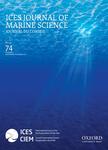版权所有:内蒙古大学图书馆 技术提供:维普资讯• 智图
内蒙古自治区呼和浩特市赛罕区大学西街235号 邮编: 010021

作者机构:Swedish Univ Agr Sci Inst Marine Res Dept Aquat Resources Lysekil Sweden Swedish Meteorol & Hydrol Inst Gothenburg Sweden Natl Marine Fisheries Res Inst Dept Fisheries Resources Gdynia Poland Inst Food Safety Anim Hlth & Environm Dept Fish Resources Res Riga Latvia Minist Agr Fisheries Serv Klaipeda Lithuania Univ Tartu Estonian Marine Inst Tallinn Estonia Thunen Inst Balt Sea Fisheries Rostock Germany
出 版 物:《ICES JOURNAL OF MARINE SCIENCE》 (海洋科学杂志)
年 卷 期:2019年第76卷第6期
页 面:1931-1931页
核心收录:
学科分类:0710[理学-生物学] 0908[农学-水产] 07[理学] 0707[理学-海洋科学]
基 金:Havs- och Vattenmyndigheten, HaV Svenska Forskningsrådet Formas Naturvårdsverket BONUS European Commission, EC
主 题:acoustic survey behavioural ecology demersal species Generalized Additive Models pelagic occurrence spatial and temporal dynamics
摘 要:Cod is usually monitored for scientific purposes using bottom trawl surveys, although its regular pelagic occurrence is well documented. Here we analysed, using Generalized Additive Models, the spatio-temporal changes in the Eastern Baltic cod adult population using pelagic catches from an acoustic survey covering 37 years and the whole central Baltic Sea. Our analysis shows that in the northern areas cod catch per unit effort (CPUE, kg h-1) was high in the early 1980s whereas it dropped and remained very low thereafter. Conversely, in the southernmost area CPUE largely oscillated after the early 1990s. Our model was able to capture key ecological features of the Baltic cod such as preferred depth of occurrence and response to hypoxic conditions. The model also revealed a clear daily cycle of CPUEs, indicating diel vertical migrations at the population level. The temporal trends of pelagic CPUEs generally followed those from the bottom trawl surveys, although differences were observed especially in the recent years with a relative decline in the cod occurring in the pelagic waters. Our results point to the great potential of acoustic survey trawl catches to complement bottom trawl surveys for investigating the spatio-temporal population dynamics and behaviour of the Baltic cod.